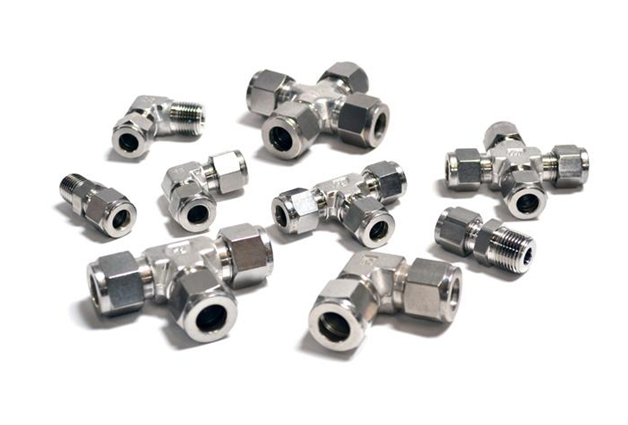Stainless steel compression fittings are used across a wide range of industries to ensure error-free and consistent processes while minimising the risk of error and ensuring long service life. Stainless steel compression fittings of other materials are also available in the industry, but the stainless steel option is highly preferred by manufacturers in a wide range of industries. The many advantages and benefits of using stainless steel fittings are the reason they are so widely used in the industry. Some of these advantages are:
Corrosion Resistant Properties
Stainless steel fittings are designed to provide corrosion-resistant properties that ensure proper functioning in a variety of industrial processes. These special properties increase the service life of the fitting.
Withstand high-pressure vibration and vacuum conditions.
Stainless steel compression fittings can withstand not only a wide range of vibrations but also a range of high-pressure vacuums commonly encountered in industrial processes. Therefore, it is a natural choice when it comes to efficient and pressure-resistant fittings.
Fitting Design
Most stainless steel pipe fittings are available in a scalable body design for easy installation and use in a variety of locations. The fittings are also manufactured with a high-quality thread design, eliminating the risk of seizure to the threads of the unit body.
Compatible with multiple tube types.
Compression fittings are not just for copper tubing. You can connect to many different pipe types and even connect between them to switch between different pipe types. Stainless steel compression fittings can be used with carbon steel and stainless steel tubing as well as plastic tubing with copper inserts provided the proper installation is considered.
Extended Service Life
Fittings are fitted with metal-to-metal sealing to ensure service life for extensive and intensive use in the industry. High-quality service fittings also ensure an excellent seal, making it easy to install hoses.
Reusable Components
When decommissioning a system, it is recommended to retain the compression fittings online for the next installation. It is easily possible with clamp fittings. Old olives are inseparable from old pipes, so new ones must be obtained.
Easy to assemble
The compression joint is easy to understand and easy to install. Simply slide the tube onto the olive and fitting and tighten the nut. Both DIY and professional installation fits seamlessly.
Heat Resistance
The grades of this material can bear high temperatures. Certain grades of stainless steel can withstand very low temperatures, resulting in very round properties in many applications.
What is Compression Joint?
The compression joint itself consists of a three-part assembly. It has union nut, olive, and right body. The seal is formed by tightening the nut around the olive and pressing it against the pipe to eliminate excess space and prevent leakage of liquids, liquids, or gases.
Where are compression fittings used?
Stainless steel compression fittings are used to create piping systems by connecting copper or plastic tubes and tubes or threaded components such as valves. Easy to install and remove, suitable for tubes that are routed in tight spaces, and difficult to solder without risking a fire.
Types of stainless steel compression
The 304 SS compression fitting is a device that works by forming a seal achieved by applying a compressive force to the tube fitting and tube. Sufficient force is applied to eliminate the space present in the fitting, pressing the fitting against the pipe and eliminating the risk of fluid leakage. The corrosion resistance power comes from high levels of chromium and nickel. Common uses of 304 stainless steel include
Appliances such as refrigerators and dishwashers,
Commercial food processing equipment,
Fasteners,
Sanitary
Heat exchangers
316 stainless steel compression fittings.
These are pressure and temperature-resistant. SS pipe compression fittings include straight, reducing, and many types of stainless steel couplers, stainless steel pipe to unions, tees, SS reducing unions, stainless steel bulkhead compression fittings, stainless steel union crosses, SS union elbows, and bulkheads, including unions.
316 Stainless Steel General Applications:
- Industrial Equipment
- Pharmaceutical Manufacturing
- Chemical Manufacturing
- Industrial and Chemical Transportation
- Pressure Vessels
- Tanks and Pipes for Chemical Applications
- Non-Surgical Steel Medical Equipment
- Marine Equipment
How does the compression adjustment work?
Compression fitting online is a relatively simple device and not difficult to use.
Threaded conical nut
Thin brass ring called “olive” or “ferrule”
Conical insert – the body of the fitting
The tight nut compresses the olive and the fitting. It forces a barrel-shaped olive ring against the outer diameter of the pipe, creating a tight seal.
Stainless Steel Compression Fittings Specification
- Sizes of the tube 1/16″ OD to 2″ OD, 2mm OD to 50mm OD
- Material Grades SS 304, SS 316, Brass, Special Alloys 300 / 1000 / 3000 PSI For Brass
- Material Grades 304 Stainless Steel, 316 Stainless Steel, Brass, Special Alloy
- SS Compression Fitting ASTM A276 ASME SA 479
- Thread BSP, BSPT, ISO, SAE, UNF, etc.
- PTFE Standard ASTM D1710, ASTM D3294
Stainless Steel Double/Twin Compression Fittings Standard Configuration
Tube Plug – Plug, Cap
Weld, Nut, Ferrule Set
Tube – Male – Male Stud, Male, Male Tee
Positionable Elbow and Tee (Swivel)
Tube – Tube – Straight, Elbow, Tee, Cross, Bulkhead
Female to Female Straight, Elbow, Tee
How tight should the compression fitting be?
The compression fitting online should be tight enough to create a watertight seal, but not so tight that it distorts the pipe or strips the threads. Hmm. Proceed with caution.
How much PSI can a compression fitting hold?
Pounds per square inch or PSI are a commonly used pressure metric. These are rugged units and stainless steel models with larger flow diameters capable of withstanding pressure applications over 10,000 PSI. As you can imagine, smaller fittings made of other materials lower his PSI rating.
Are the gas and water compression fittings the same?
No big difference. Fluid-rated compression fittings online are suitable for gas, but if using the optional PTFE tape, ensure it is gas-rated. Also, make sure your fixtures are accessible and not hidden behind walls or under floors.



